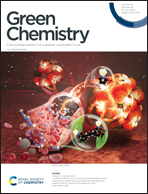Diluted aqueous ionic liquid assists the acidic oxidative hydrolysis of water-soluble recalcitrant polysaccharide xanthan through structural deterioration†
Abstract
Pure or highly concentrated ionic liquids (ILs, CIL > 40% v/v) have been widely applied for the preparation of value-added products from polysaccharides by breaking their hydrogen bonds. Reducing the dosage of ILs would benefit the establishment of a greener process. However, the effect of low-concentration ILs on the pretreatment of polysaccharides, especially water-soluble recalcitrant polysaccharides, has not been fully investigated. In this study, aqueous [Bmim]Cl (1-butyl-3-methylimidazolium chloride) with different dilution ratios was applied to treat xanthan gum (XG) and assist XG hydrolysis. Structural characterization and hydrolysate analyses showed that 1% (v/v) [Bmim]Cl could effectively break intramolecular hydrogen bonds of XG through the binding of [Bmim]+ to XG side chains, disrupting the XG conformation. Such changes increased the accessibility of XG for chemical reagents. Moreover, [Bmim]Cl could significantly increase the content of hydroxyl and superoxide radicals (from H2O2) in the reaction system. These interactions strengthened the acidic oxidative hydrolysis of XG. Notably, a low concentration of [Bmim]Cl was proved to inhibit the Maillard browning of the acidic oxidative hydrolysis system, which also contributed to XG degradation. Under hydrolysis conditions of 0.4 M HCl, 0.75% (w/v) H2O2 and 1% (v/v) [Bmim]Cl for 4 days at 80 °C, XG could be hydrolyzed into a mixture with a high dextrose equivalent value of 29.16% containing 25 types of oligosaccharides. Meanwhile, the XG hydrolysates showed good antioxidant ability and elicitor activity against soybean cotyledon. Our work should be valuable for establishing a green and economic platform for valorizing water-soluble recalcitrant polysaccharides.



 Please wait while we load your content...
Please wait while we load your content...